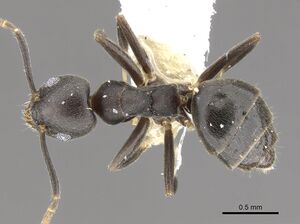Technomyrmex fornax
| Technomyrmex fornax | |
|---|---|

| |
| Scientific classification | |
| Kingdom: | Animalia |
| Phylum: | Arthropoda |
| Class: | Insecta |
| Order: | Hymenoptera |
| Family: | Formicidae |
| Subfamily: | Dolichoderinae |
| Genus: | Technomyrmex |
| Species: | T. fornax |
| Binomial name | |
| Technomyrmex fornax Bolton, 2007 | |
Specimens have been collected from rainforest, from a fallen tree and as a forager (presumably from the ground).
Identification
Bolton (2007) - A member of the T. pallipes complex in the Technomyrmex albipes group. This species superficially resembles the widespread Technomyrmex difficilis but differs by the presence of an extra pair of short setae on the dorsum of the head, close to the level of the posterior margin of the eye, and in the proportions of the propodeum. In difficilis the length of the propodeal dorsum in profile is always distinctly shorter than the depth of the declivity to the spiracle and the dorsum meets the declivity in an angle. In fornax the length of propodeal dorsum in profile is about equal to the depth of the declivity to the spiracle and the dorsum meets the declivity in a bluntly rounded curve.
Keys including this Species
Distribution
Sabah, Malaysia.
Latitudinal Distribution Pattern
Latitudinal Range: 2.8° to 2.8°.
| North Temperate |
North Subtropical |
Tropical | South Subtropical |
South Temperate |
- Source: AntMaps
Distribution based on Regional Taxon Lists
Indo-Australian Region: Borneo (type locality), Indonesia, Malaysia.
Distribution based on AntMaps
Distribution based on AntWeb specimens
Check data from AntWeb
Countries Occupied
| Number of countries occupied by this species based on AntWiki Regional Taxon Lists. In general, fewer countries occupied indicates a narrower range, while more countries indicates a more widespread species. |

|
Estimated Abundance
| Relative abundance based on number of AntMaps records per species (this species within the purple bar). Fewer records (to the left) indicates a less abundant/encountered species while more records (to the right) indicates more abundant/encountered species. |

|
Biology
Castes
Worker
Images from AntWeb
   
| |
| Holotype of Technomyrmex fornax. Worker. Specimen code casent0903041. Photographer Will Ericson, uploaded by California Academy of Sciences. | Owned by NHMUK, London, UK. |
Nomenclature
The following information is derived from Barry Bolton's Online Catalogue of the Ants of the World.
- fornax. Technomyrmex fornax Bolton, 2007a: 80, fig. 45 (w.) BORNEO.
Unless otherwise noted the text for the remainder of this section is reported from the publication that includes the original description.
Description
Worker
Holotype. TL 2.7, HL 0.64, HW 0.60, SL 0.66, PW 0.42, WL 0.84. Indices: CI 94, SI 110,0130, EPI 77, DTI 129.
Frontal carina with 2 setae that are shorter than the maximum diameter of the eye: in profile the first above the torulus, the second at the level of the anterior margin of the eye. A much shorter pair of setae, about half the length of those on the frontal carina, is present close to the level of the posterior margin of the eye. Dorsum of head posterior to this with a single pair of short setae, in profile located just over half way between level of posterior margin of eye and posterior margin of head, this pair of setae only about 0.45 x the maximum diameter of the eye. Anterior clypeal margin with an extremely shallow median concavity. With head in full-face view the Sides convex and the posterior margin with a shallow median concavity. Eyes located well in front of mid length, EPI 77; outer margin of eye conspicuously breaks the outline of the side in full-face view. Number of setal pairs on mesosoma: pronotum 1; mesonotum 2, very short, one anterior the other posterior; propodeal dorsum 0; lateral margins of propodeal declivity 2, above the level of the spiracle. With mesosoma in profile the mesonotal outline is evenly curved, without a distinct step or angle in the outline that defines conspicuous dorsal and declivitous faces. Dorsum of propodeum in profile meets the declivity in a bluntly rounded curve; length of dorsum is about equal to depth of declivity to spiracle. In dorsal view the metathoracic spiracles are very close to the metanotal groove. Gastral tergites 1 - 4 each with numerous short, stubbly setae, distributed everywhere on the sclerites; all setae on first gastral tergite are distinctly shorter than the maximum diameter of the eye at maximum only about 0.50 x the maximum eye diameter. Head, mesosoma, petiole and gaster blackish brown to black. Coxae, femora and tibiae the same colour as the mesosoma or slightly lighter. Tarsi of middle and hind legs yellowish white to yellow, distinctly paler than the tibiae.
Paratype. TL 2.6, HL 0.62, HW 0.58, SL 0.64, PW 0.38, WL 0.84. Indices: CI 94, SI 110, OI 29, EPI 80, DTI 135. As holotype.
Type Material
Holotype worker (upper of 2 specimens on pin), Malaysia: Sabah, Crocker Ra., 17.v.1987, 1350 m., 28d (Burckhardt & Lobi) (The Natural History Museum). Paratype, 1 worker (lower of 2 on pin), with same data (BMNH).
References
- Bolton, B. 2007. Taxonomy of the dolichoderine ant genus Technomyrmex Mayr (Hymenoptera: Formicidae) based on the worker caste. Contributions of the American Entomological Institute. 35(1):1-149.
References based on Global Ant Biodiversity Informatics
- Bolton B. 2007. Taxonomy of the dolichoderine ant genus Technomyrmex Mayr (Hymenoptera: Formicidae) based on the worker caste. Contributions of the American Entomological Institute 35(1): 1-150.
- Bolton, B. "Taxonomy of the dolichoderine ant genus Technomyrmex Mayr (Hymenoptera: Formicidae) based on the worker caste." Contributions of the American Entomological Institute 35, no. 1 (2007): 1-149.
- Pfeiffer M.; Mezger, D.; Hosoishi, S.; Bakhtiar, E. Y.; Kohout, R. J. 2011. The Formicidae of Borneo (Insecta: Hymenoptera): a preliminary species list. Asian Myrmecology 4:9-58

